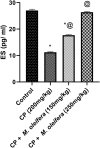Ovario- protective effect of Moringa oleifera leaf extract against cyclophosphamide-induced oxidative ovarian damage and reproductive dysfunction in female rats
- PMID: 39774723
- PMCID: PMC11706964
- DOI: 10.1038/s41598-024-82921-7
Ovario- protective effect of Moringa oleifera leaf extract against cyclophosphamide-induced oxidative ovarian damage and reproductive dysfunction in female rats
Abstract
It is crucial to develop new tactics to prevent ovarian tissue damage in women whose reproductive toxicity is caused by chemotherapy. The present investigation was performed to assess the protective effects of Moringa oleifera (M. oleifera) leaf extract on cyclophosphamide (CP)-induced ovarian damage and reproductive dysfunction. Thirty-two female, healthy Wistar albino rats were randomly assigned to four groups (8 rats/group). The first group was given saline intraperitoneally (i.p.). The second group was given a single dose of CP (200 mg/kg; i.p.). The third and fourth groups were given M. oleifera leaf extract (150 and 250 mg/kg; orally) for 20 days before receiving CP on the final day of the experiment. Hormonal assessments, including follicle stimulating hormone (FSH), luteinizing hormone (LH), and estrogen (ES), were performed 24 h after CP administration. In addition, the antioxidant status and inflammatory response against CP were evaluated. Moreover, detailed histopathological and ultra- structural observations were conducted. For evaluation of statistical significance between different groups; One-way analysis of variance (ANOVA) with Tukey's post hoc test was adopted. Our findings revealed that rats subjected to CP showed increased levels of FSH, LH, malondialdehyde (MDA), tumor necrosis factor-alpha, and interleukin-8 and decreased levels of ES and glutathione. Pre-treatment with M. oleifera leaf extract (250 mg/kg; orally) was statistically significant (p values < 0.05) as it could improve hormonal changes, oxidative stress indices, and pro- inflammatory mediator levels. Consequently, a marked improvement was observed in the ovarian and uterine architectures, with a normal ovarian reserve and a normal endothelium with normal tubular glands. In conclusion, M. oleifera leaf extract (250 mg/kg) could be used as a pharmaceutical supplement because it protects female rats against CP-induced ovarian damage and reproductive dysfunction.
Keywords: Moringa oleifera; Cyclophosphamide; Ovarian function; Oxidative stress; Pro-inflammatory mediators.
© 2024. The Author(s).
Conflict of interest statement
Declarations. Competing interests: The authors declare no competing interests. Ethics approval and consent to participate: All experimental procedures were conducted following the recommendations of the National Institutes of Health Guide for Care and Use of Laboratory Animals (NIH Publications No. 8023, revised 1978) and after the approval of the National Research Centre–Medical Research Ethics Committee (NRC-MREC) for the use of animal subjects (Approval No. 2411022023).
Figures








References
Publication types
MeSH terms
Substances
LinkOut - more resources
Full Text Sources
Miscellaneous

